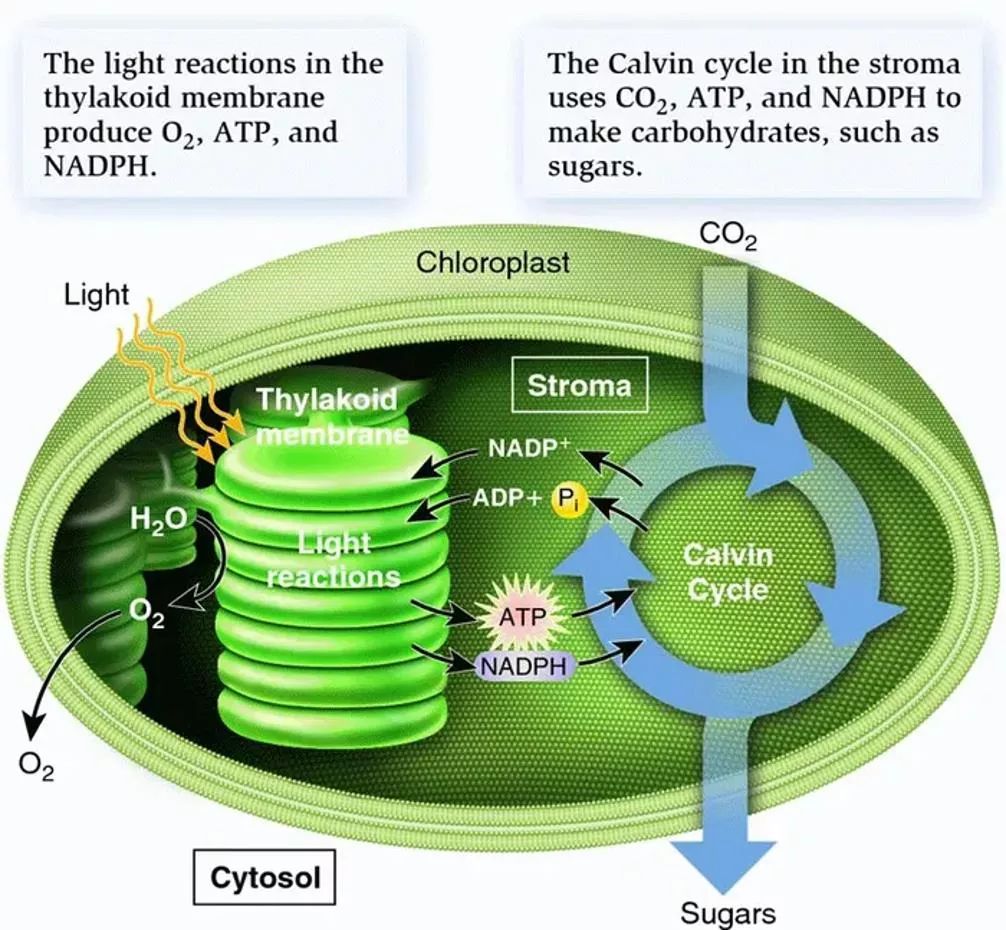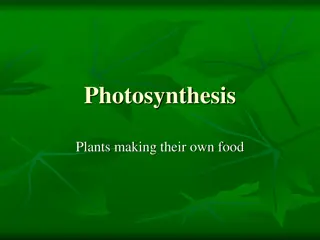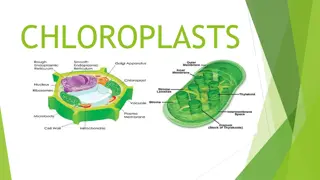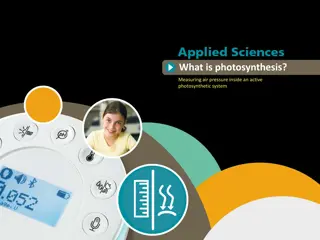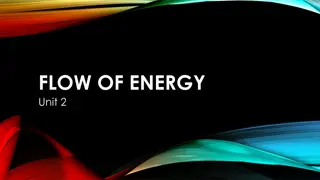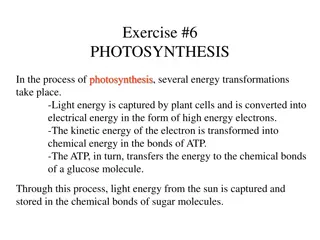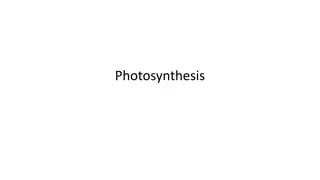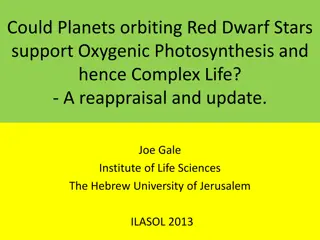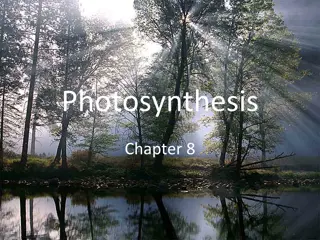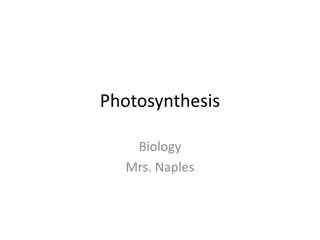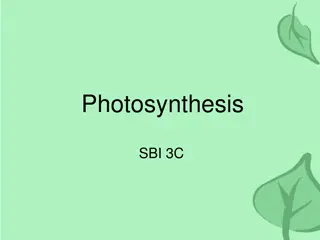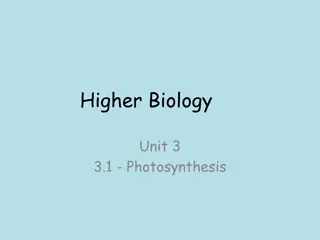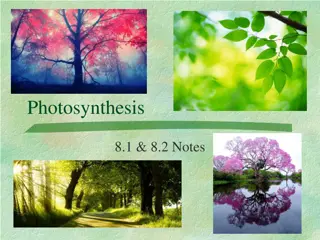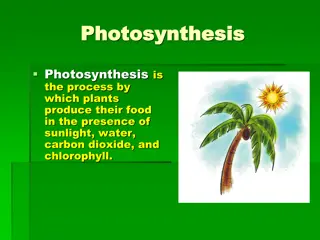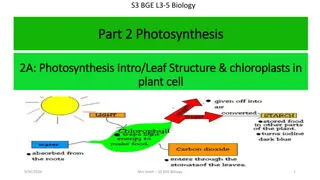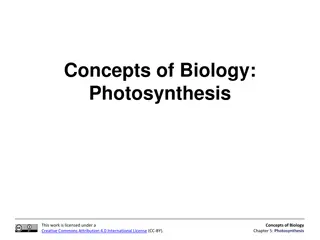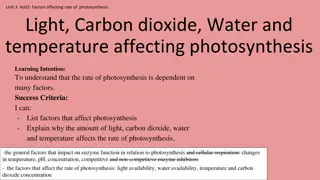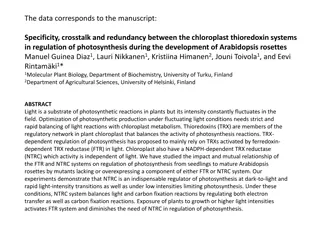Understanding the Role of Rubisco in Photosynthesis
Photosynthesis involves two stages, with Rubisco playing a crucial role in the light-independent stage by assisting in carbon dioxide fixation. It controls the initial reaction, converting CO2 into organic molecules essential for plant growth. Different adaptations in C3, C4, and CAM plants optimize Rubisco's efficiency in various environments. Understanding how Rubisco functions is key to comprehending the complexity of photosynthesis.
Download Presentation

Please find below an Image/Link to download the presentation.
The content on the website is provided AS IS for your information and personal use only. It may not be sold, licensed, or shared on other websites without obtaining consent from the author. Download presentation by click this link. If you encounter any issues during the download, it is possible that the publisher has removed the file from their server.
E N D
Presentation Transcript
Unit 3: AoS2- Rubisco in C3, C4 and CAM photosynthesis Rubisco in C3, C4 and CAM photosynthesis and adaptations Learning Intention: To understand how the enzyme rubisco is critical to photosynthesis Success Criteria: I can - Define Rubisco - List adaptations in C4 and CAM plants - Describe why Rubisco requires plant adaptations - the general role of enzymes and coenzymes in facilitating steps in photosynthesis and cellular respiration - the role of Rubisco in photosynthesis, including adaptations of C3, C4and CAM plants to maximise the efficiency of photosynthesis
Photosynthesis occurs over two stages: 1. The light-dependent stage where light energy splits water molecules to produce ATP, NADPH, and oxygen. This stage occurs in the thylakoid membranes of the grana. 2. The light-independent stage where carbon dioxide is converted into organic molecules using ATP and NADPH, and more water is produced. This stage occurs in the stroma, and is also known as the Calvin cycle. Virtually all of these small steps in the reactions are controlled by enzymes. Rubisco is a crucial enzyme that is involved in the light-independent stage.
RUBISCO- ribulose bisphosphate carboxylase-oxygenase Rubisco is a key enzyme of the light-independent stage of photosynthesis. It can: - bind to carbon dioxide and facilitates further reactions in the photosynthesis process - binds to oxygen and initiates a wasteful process called photorespiration. Rubisco molecule
Role of Rubisco Rubisco controls the first reaction in the light-independent stage of Photosynthesis. In the process: - Rubisco uses 3 CO2 molecules and 3 five-carbon molecules (called RuBP) to produce 6 three-carbon molecules (called 3-PGA). - The 6 3-PGA are then converted by ATP and NADPH from the light-dependent reactions to make different 6 x three-carbon molecules (called G3P). - One G3P molecule then leaves the cycle to undergo further reactions to contribute to making glucose. Note: 3 CO2 molecules must cycle in order for one G3P to leave, and two G3P (three- carbon) leaving are required to build one glucose (six-carbon), therefore 6 CO2 must enter to produce one glucose molecule. - The remaining 5 G3P are recycled with the help of ATP to regenerate the 3 RuBP we had at the start of the cycle, and the cycle begins all over again. Overall, the cycle must turn twice to produce one glucose molecule (3 CO2 goes in twice, to contribute to six- carbon glucose).
All of this cycling around and around between carbon molecules is to produce glucose from CO2, NADPH, and ATP. Plants cannot convert CO2 directly into glucose as it would waste too much energy. Instead, the cycle allows for the most effective way to use CO2 to produce glucose. To summarise, the previously mentioned steps demonstrate the chemical processes involved in the light-independent stage. Ultimately though, it can be helpful to think of the overall steps of the process as being part of three overarching stages (Figure 2): 1. Carbon fixation which refers to the conversion of CO2 and RuBP into 3-PGA. Here, we say that the carbon from the inorganic CO2 is fixed into an organic compound. Rubisco is responsible for taking carbon from an inorganic, gaseous form (CO2) and incorporating it into an organic compound (3-PGA) 2. Reduction NADPH donates electrons to (aka reduces ) an intermediate three-carbon molecule in the cycle to produce G3P 3. Regeneration the RuBP molecules needed to start the cycle again are reproduced.
Flaw in Rubisco Sometimes, rather than using CO2 as a substrate, it uses O2 instead. Without the Rubisco-CO2 pairing, photosynthesis cannot proceed. When Rubisco binds to O2 instead, a different reaction called photorespiration occurs. Less photosynthesis means less glucose is produced, which, combined with wasted energy used in the photorespiration pathway, negatively impacts a plant s ability to grow, survive, and reproduce. This is why we say photorespiration is an unwanted and wasteful process in plants.
Factors influencing whether Rubisco binds CO2 or O2 The two key factors that influence whether Rubisco binds CO2 or O2 are: 1. Substrate concentration 2. Temperature 1. Substrate concentration The more substrate is present, the greater chance it can bind to an enzyme and undergo a reaction. So, plants want to expose Rubisco to a high CO2 concentration and a low O2 concentration. To facilitate this, the stomata of the plant leaves open to allow CO2 to enter the plant, while O2 and water vapour simultaneously diffuse out of the plant. 2. Temperature- At regular temperatures, Rubisco s affinity for CO2 is far greater than that for O2. At higher temperatures, the affinity for O2 is higher, leading to Rubisco binding oxygen more often. Note: When a plant needs to conserve water it will close its stomata, causing the O2 produced during the light-dependent stage of photosynthesis to build up inside its cells. A greater concentration of oxygen in the cells leads to increased photorespiration.
Note: As temperature increases, the bonds holding Rubisco together loosen , which changes the 3D shape of the enzyme, resulting in a greater affinity towards oxygen. As the temperature continues to increase, the entire enzyme will denature and no reactions would take place at all.
C3 Plants - - - Make up 83% of all plants No adaptations to reduce photorespiration Rubisco is responsible for fixing carbon dioxide into three carbon compounds (3-PGA)
C4 Plants - Light dependent stage is exactly the same as C3 plants Light independent is different Initial carbon fixation happens in mesophyll cell. Remaining occurs in bundle-sheath cells. C4 is the name from the first four carbon molecule produced in the initial carbon fixation - -
CAM Plants - Minimise photorespiration by separating initial carbon fixation and the remainder of the Calvin cycle over time Light dependent stage is identical to C3 plants Light independent stage happens by separating the initial carbon fixation over time. At night CAM plants open the stomata to bring in carbon dioxide. The carbon dioxide is fixed into a four carbon molecule which is stored inside the vacuole until day time. During the day CAM plants don t open their stomata so they can save water. - - - -
ACTIVITY 5B 2-6, 11-14 Biozone 46





